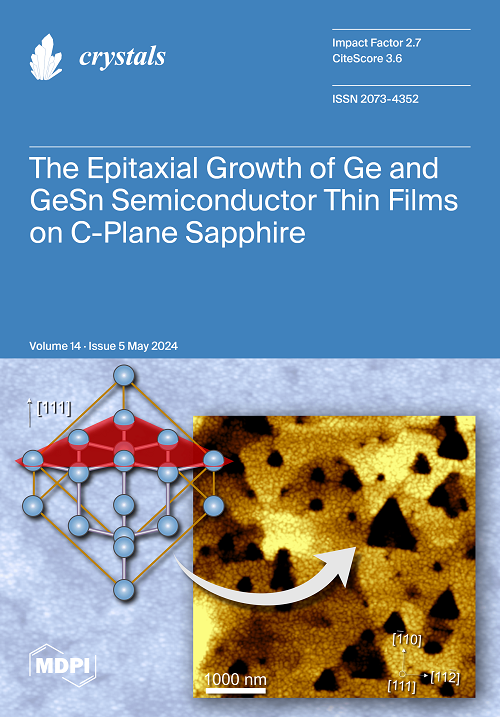Advances in the Parameter Space Concept towards Picometer Precise Crystal Structure Refinement—A Resolution Study
IF 2.4
4区 材料科学
Q2 CRYSTALLOGRAPHY
引用次数: 0
Abstract
The Parameter Space Concept (PSC) is an alternative approach to solving and refining (partial) crystal structures from very few pre-chosen X-ray or neutron diffraction amplitudes without the use of Fourier inversion. PSC interprets those amplitudes as piecewise analytic hyper-surfaces, so-called isosurfaces, in the Parameter Space, which is spanned by the spatial coordinates of all atoms of interest. The intersections of all isosurfaces constitute the (possibly degenerate) structure solution. The present feasibility study investigates the La and Sr split position of the potential high-temperature super-conductor (La0.5Sr1.5)MnO4, I4/mmm, with a postulated total displacement between La and Sr of a few pm by theoretical amplitudes of pre-selected 00l reflections (l=2,4,…,20). The revision of 15-year-old results with state-of-the-art computing equipment enhances the former simplified model by varying the scattering power ratio ferrortypeceLa/ferrortypeceSr, as exploitable by means of resonant scattering contrast at synchrotron facilities, and irrevocably reveals one of the two originally proposed solutions as being a “blurred” pseudo-solution. Finally, studying the resolution limits of PSC as a function of intensity errors by means of Monte-Carlo simulations shows both that the split can only be resolved for sufficiently low errors and, particularly for the resonant scattering contrast, a theoretical precision down to ±0.19pm can be achieved for this specific structural problem.参数空间概念在实现皮米精度晶体结构精细化方面的进展--分辨率研究
参数空间概念(PSC)是另一种无需使用傅立叶反演即可通过预先选择的极少量 X 射线或中子衍射振幅求解和完善(部分)晶体结构的方法。PSC 将这些振幅解释为参数空间(Parameter Space)中的片断解析超曲面(即所谓的等值面),参数空间由所有相关原子的空间坐标跨越。所有等值面的交点构成(可能是退化的)结构解。本可行性研究调查了潜在高温超导体 (La0.5Sr1.5)MnO4, I4/mmm 的 La 和 Sr 分裂位置,通过预选的 00l 反射(l=2,4,..,20)的理论振幅,推测 La 和 Sr 之间的总位移为几个 pm。利用最先进的计算设备对 15 年前的结果进行修正,通过改变散射功率比 ferrortypeceLa/ferrortypeceSr (可通过同步加速器设施的共振散射对比进行利用),增强了之前的简化模型,并无可挽回地揭示了最初提出的两个解决方案之一是一个 "模糊 "的伪解决方案。最后,通过蒙特卡洛模拟研究了 PSC 分辨率极限与强度误差的函数关系,结果表明只有在误差足够小的情况下才能分辨出分裂,尤其是共振散射对比度,对于这个特定的结构问题,理论精度可以低至 ±0.19pm。
本文章由计算机程序翻译,如有差异,请以英文原文为准。
求助全文
约1分钟内获得全文
求助全文
来源期刊

Crystals
CRYSTALLOGRAPHYMATERIALS SCIENCE, MULTIDIS-MATERIALS SCIENCE, MULTIDISCIPLINARY
CiteScore
4.20
自引率
11.10%
发文量
1527
审稿时长
16.12 days
期刊介绍:
Crystals (ISSN 2073-4352) is an open access journal that covers all aspects of crystalline material research. Crystals can act as a reference, and as a publication resource, to the community. It publishes reviews, regular research articles, and short communications. Our aim is to encourage scientists to publish their experimental and theoretical results in as much detail as possible. Therefore, there is no restriction on article length. Full experimental details must be provided to enable the results to be reproduced. Crystals provides a forum for the advancement of our understanding of the nucleation, growth, processing, and characterization of crystalline materials. Their mechanical, chemical, electronic, magnetic, and optical properties, and their diverse applications, are all considered to be of importance.
 求助内容:
求助内容: 应助结果提醒方式:
应助结果提醒方式:


